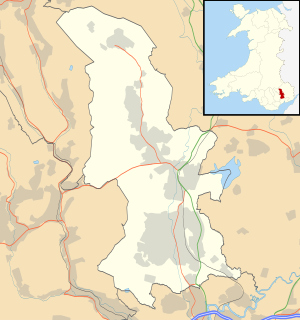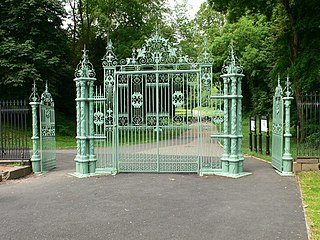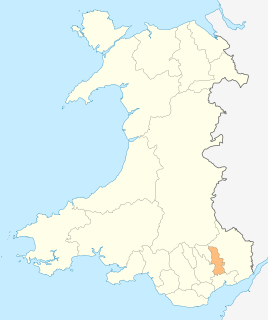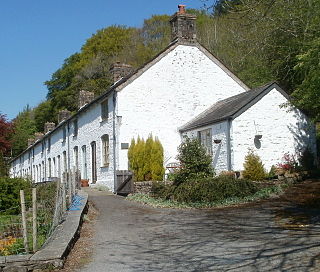
Abersychan is a town and community north of Pontypool in Torfaen, Wales, and lies within the boundaries of the historic county of Monmouthshire and the preserved county of Gwent.

Torfaen is a county borough in the south-east of Wales. Torfaen is bordered by the county of Monmouthshire to the east, the city of Newport to the south, and the county boroughs of Caerphilly and Blaenau Gwent to the south-west and north-west respectively. It is within the boundaries of the historic county of Monmouthshire, and between 1974 and 1996 was a district of Gwent, until it was reconstituted as a principal area in 1996.

Pontypool is a town and the administrative centre of the county borough of Torfaen, within the historic boundaries of Monmouthshire in South Wales. It has a population of 28,970.

Blaenavon is a town and community in Torfaen county borough, Wales, high on a hillside on the source of the Afon Lwyd. It is within the boundaries of the historic county of Monmouthshire and the preserved county of Gwent. The population is 6,055.

Blaenavon Industrial Landscape, in and around Blaenavon, Torfaen, Wales, was inscribed a World Heritage Site by UNESCO in 2000. The Blaenavon Ironworks, now a museum, was a major centre of iron production using locally mined or quarried iron ore, coal and limestone. Raw materials and products were transported via horse-drawn tramroads, canals and steam railways. The Landscape includes protected or listed monuments of the industrial processes, transport infrastructure, workers' housing and other aspects of early industrialisation in South Wales.

Fairwater is a community and suburb of Cwmbran in the county borough of Torfaen, in south east Wales, and was built by the Cwmbran Development Corporation between 1963 and 1966.
Pontnewynydd is a predominantly working class suburb of Pontypool, Torfaen, in Wales. It should not be confused with Pontnewydd in nearby Cwmbran.

Pontypool Park is a 150-acre (0.61 km2) park in Pontypool, Torfaen, Wales. The park was formerly the grounds of Pontypool House and was laid out in the closing years of the 17th century for John Hanbury, an ironmaster, who is closely associated with Japanware. The grounds were purchased by the local authority in 1920, while the estate house was leased, and later sold, to the Sisters of the Holy Ghost to become St. Alban's RC High School. The former stables now house the Torfaen Museum. The grounds contain a number of structures including a double ice house, the Folly Tower and the Shell Grotto. The park is entered through the Pontymoile Gates. The gates, the grotto and the stables are all Grade II* listed structures, while the former hall and the ice house are listed Grade II.
Forge Side was the site of an ironworks started in 1836. The development was soon abandoned, but resumed in 1859. A settlement of houses was built for the workers.

The Afon Lwyd or Afon Llwyd is a 13-mile (21 km) long river in south-east Wales which flows from its source northwest of Blaenavon, through Abersychan, Pontnewynydd, Pontypool, Llanfrechfa and Cwmbran before flowing, at Caerleon, into the River Usk, which subsequently flows into the Bristol Channel to the south of Newport.
The Monmouthshire Railway and Canal Company was a canal and railway company that operated a canal and a network of railways in the Western Valley and Eastern Valley of Newport, Monmouthshire. It started as the Monmouthshire Canal Navigation and opened canals from Newport to Pontypool and to Crumlin from 1796. Numerous tramroads connected nearby pits and ironworks with the canal.

Blaenavon Ironworks is a former industrial site which is now a museum in Blaenavon, Wales. The ironworks was of crucial importance in the development of the ability to use cheap, low quality, high sulphur iron ores worldwide. It was the site of the experiments by Sidney Gilchrist Thomas and his cousin Percy Gilchrist that led to "the basic steel process" or "Gilchrist–Thomas process".

In the United Kingdom, the term listed building refers to a building or other structure officially designated as being of special architectural, historical, or cultural significance; Grade II* structures are those considered to be "particularly important buildings of more than special interest". Listing was begun by a provision in the Town and Country Planning Act 1947. Once listed, strict limitations are imposed on the modifications allowed to a building's structure or fittings. In Wales, the authority for listing under the Planning Act 1990 rests with Cadw.
The Blaenavon Railroad was a horse drawn tramroad built to link Blaenavon Ironworks with the Monmouthshire Canal in south east Wales.
Thomas Hill of Dennis, also known as Thomas Hill or latterly Thomas Hill I, to distinguish him from his son, was an ironmaster, and the leading partner in the establishment of Blaenavon Ironworks in south east Wales.

Forge Row is a terrace of seven, originally twelve, cottages build around 1804 for workers at a nearby forge in Cwmavon, Torfaen, south east Wales. The cottages have been sympathetically restored. The terrace is regarded as a fine example of early housing for industrial workers in South Wales, and all the cottages are Grade II* listed buildings. The cottages lie to the east of the Afon Llwyd river.

Caerleon Tramroad was an early horse-drawn tramway built in 1794 or 1795 by Nicholas Blannin to link the forge he rented in Caerleon with the Monmouthshire Canal at Clomendy, which is now part of Cwmbran.
Snatchwood Halt railway station served Snatchwood between Pontypool and Abersychan in Torfaen, South Wales, UK. The station was opened by the Great Western Railway in 1912 on the line it had purchased from the Monmouthshire Railway and Canal Company in 1880. The Halt lay between Pontypool Crane Street to the south and Abersychan to the north. The Halt lay adjacent to the current A4043 road, between the road and the nearby Afon Lwyd.














